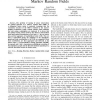Free Online Productivity Tools
i2Speak
i2Symbol
i2OCR
iTex2Img
iWeb2Print
iWeb2Shot
i2Type
iPdf2Split
iPdf2Merge
i2Bopomofo
i2Arabic
i2Style
i2Image
i2PDF
iLatex2Rtf
Sci2ools
CISS
2007
IEEE
2007
IEEE
Energy Efficient Routing for Statistical Inference of Markov Random Fields
The problem of routing of sensor observations for optimal detection of a Markov random field (MRF) at a designated fusion center is analyzed. Assuming that the correlation structure of the MRF is defined by the nearestneighbor dependency graph, routing schemes which minimize the total energy consumption are analyzed. It is shown that the optimal routing scheme involves data fusion at intermediate nodes and requires transmissions of two types viz., the raw sensor data and the aggregates of log-likelihood ratio (LLR). The raw data is transmitted among the neighbors in the dependency graph and local contributions to the LLR are computed. These local contributions are then aggregated and delivered to the fusion center. A 2-approximation routing algorithm (DFMRF) is proposed and it has a transmission multidigraph consisting of the dependency graph and the directed minimum spanning tree, with the directions toward the fusion center.
| Added | 14 Aug 2010 |
| Updated | 14 Aug 2010 |
| Type | Conference |
| Year | 2007 |
| Where | CISS |
| Authors | Animashree Anandkumar, Lang Tong, Ananthram Swami |
Comments (0)

